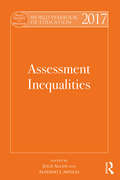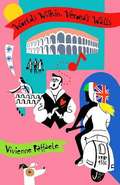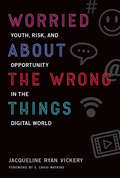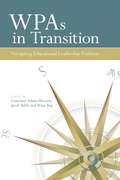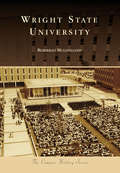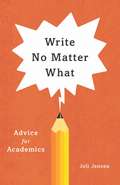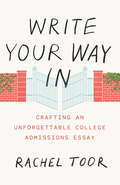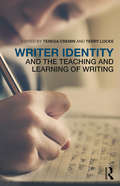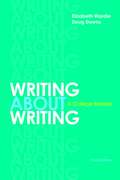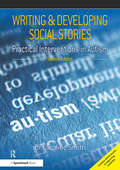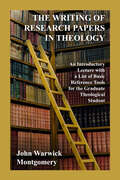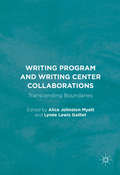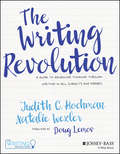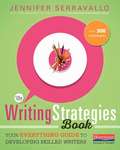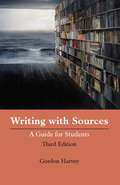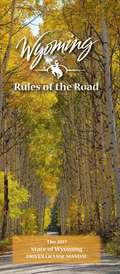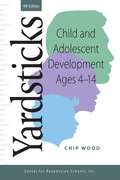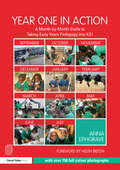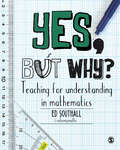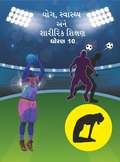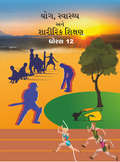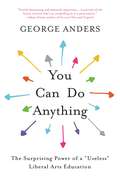- Table View
- List View
World Yearbook of Education 2017: Assessment Inequalities (World Yearbook of Education)
by Alfredo J. Artiles Julie AllanThis latest volume in the World Yearbook of Education series examines the relationship between assessment systems and efforts to advance equity in education at a time of growing inequalities. It focuses on the political motives behind the expansion of an assessment industry, the associated expansion of an SEN industry and a growth in consequential accountability systems. Split into three key sections, the first part is concerned with the assessment industry, and considers the purpose and function of assessment in policy and politics and the political context in which particular assessment practices have emerged. Part II of the book, on assessing deviance, explores those assessment and identification practices that seek to classify different categories of learners, including children with Limited English Proficiency, with special needs and disabilities and with behavioural problems. The final part of the book considers the consequences of assessment and the possibility of fairer and more equitable alternatives, examining the production of inequalities within assessment in relation to race, class, gender and disability. Discussing in detail the complex historical intersections of assessment and educational equity with particular attention to the implications for marginalised populations of students and their families, this volume seeks to provide reframings and reconceptualisations of assessment and identification by offering new insights into economic and cultural trends influencing them. Co-edited by two internationally renowned scholars, Julie Allan and Alfredo J. Artiles, World Yearbook of Education 2017 will be a valuable resource for researchers, graduates and policy makers who are interested in the economic trends of global education assessment.
Worlds Within Verona's Walls
by Vivienne Raffaele<P>An engaging account of the lives and loves of three English teachers at the same school in Italy whose friendship develops over the course of the academic year.<P> Their intertwining stories are set against the background of a city inextricably linked to love and romance: Verona.
Worried About the Wrong Things: Youth, Risk, and Opportunity in the Digital World (The John D. and Catherine T. MacArthur Foundation Series on Digital Media and Learning)
by Jacqueline Ryan VickeryWhy media panics about online dangers overlook another urgent concern: creating equitable online opportunities for marginalized youth.It's a familiar narrative in both real life and fiction, from news reports to television storylines: a young person is bullied online, or targeted by an online predator, or exposed to sexually explicit content. The consequences are bleak; the young person is shunned, suicidal, psychologically ruined. In this book, Jacqueline Ryan Vickery argues that there are other urgent concerns about young people's online experiences besides porn, predators, and peers. We need to turn our attention to inequitable opportunities for participation in a digital culture. Technical and material obstacles prevent low-income and other marginalized young people from the positive, community-building, and creative experiences that are possible online.Vickery explains that cautionary tales about online risk have shaped the way we think about technology and youth. She analyzes the discourses of risk in popular culture, journalism, and policy, and finds that harm-driven expectations, based on a privileged perception of risk, enact control over technology. Opportunity-driven expectations, on the other hand, based on evidence and lived experience, produce discourses that acknowledge the practices and agency of young people rather than seeing them as passive victims who need to be protected.Vickery first addresses how the discourses of risk regulate and control technology, then turns to the online practices of youth at a low-income, minority-majority Texas high school. She considers the participation gap and the need for schools to teach digital literacies, privacy, and different online learning ecologies. Finally, she shows that opportunity-driven expectations can guide young people's online experiences in ways that balance protection and agency.
WPAs in Transition: Navigating Educational Leadership Positions
by Courtney Adams WootenWPAs in Transition shares a wide variety of professional and personal perspectives about the costs, benefits, struggles, and triumphs experienced by writing program administrators making transitions into and out of leadership positions. Contributors to the volume come from various positions, as writing center directors, assistant writing program administrators, and WPAs; mixed settings, including community colleges, small liberal arts colleges, and research institutions; and a range of career stages, from early to retiring. They recount insightful anecdotes and provide a scholarly context in which WPAs can share experiences related to this long-ignored aspect of their work. During such transitions, WPAs and other leaders who function as both administrators and faculty face the professional and personal challenges of redefining who they are, the work they do, and with whom they collaborate. WPAs in Transition creates a grounded and nuanced experiential understanding of what it means to navigate changing roles, advancing the dialogue around WPAs’ and other administrators’ identities, career paths, work-life balance, and location, and is a meaningful addition to the broader literature on administration and leadership. Contributors: Mark Blaauw-Hara, Christopher Blankenship, Jennifer Riley Campbell, Nicole I. Caswell, Richard Colby, Steven J. Corbett, Beth Daniell, Laura J. Davies, Jaquelyn Davis, Holland Enke, Letizia Guglielmo, Beth Huber, Karen Keaton Jackson, Rebecca Jackson, Tereza Joy Kramer, Jackie Grutsch McKinney, Kerri K. Morris, Liliana M. Naydan, Reyna Olegario, Kate Pantelides, Talinn Phillips, Andrea Scott, Paul Shovlin, Bradley Smith, Cheri Lemieux Spiegel, Sarah Stanley, Amy Rupiper Taggart, Molly Tetreault, Megan L. Titus, Chris Warnick
Wright State University (Campus History)
by Rebekkah MulhollandPlans to establish the first public institution of higher education in the Dayton region were laid in 1961. At the time, Dayton was the second largest metropolitan city in Ohio. The need for a public higher-education institution became critical as Dayton emerged as a center of high technology that needed an educated workforce. In 1962, many key business leaders throughout the community led a community-wide fundraising effort to secure the necessary seed money for the branch campus of Ohio State University and Miami University. In the fall of 1964, with the completion of Allyn Hall, the “campus within a building,” the Dayton campus of Ohio State University and Miami University opened its doors to 3,203 enrolled students. It became an independent institution in 1967 and was named Wright State University to honor Dayton natives and aviation pioneers Orville and Wilbur Wright. Under the leadership of its sixth president, David Hopkins, Wright State University continued to expand its campus while building lasting relationships with the community.
Wrightslaw: All About Tests And Assessments (Second Edition)
by Melissa FarrallWhen a child is struggling in school, you need to find out why. If you are concerned about a child's learning, academic progress, social skills, or behavior, a comprehensive assessment is the first step to developing a plan to help. <p><p> If you are like most people, you have questions about tests. How do tests measure skills? What do the test scores mean? Are some tests better than others? What should I do to prepare for an assessment? What should a comprehensive assessment include? <p> The goal of Wrightslaw: All About Tests and Assessments, 2nd Edition is to demystify the assessment process and make it less intimidating. <p> Wrightslaw: All About Tests and Assessments, 2nd Edition includes: <p> The Wechsler Intelligence Scale for Children, Fifth Edition (WISC-V) and the Woodcock-Johnson Tests of Achievement, Fourth Edition (WJ IV). <p> More than 200 answers to questions about tests in fifteen areas. <p> Strengths, weaknesses, and potential problems with tests. <p> Charts of tests that assess specific skills and abilities.
Write No Matter What: Advice for Academics
by Joli JensenWith growing academic responsibilities, family commitments, and inboxes, scholars are struggling to fulfill their writing goals. A finished book—or even steady journal articles—may seem like an impossible dream. But, as Joli Jensen proves, it really is possible to write happily and productively in academe. Jensen begins by busting the myth that universities are supportive writing environments. She points out that academia, an arena dedicated to scholarship, offers pressures that actually prevent scholarly writing. She shows how to acknowledge these less-than-ideal conditions, and how to keep these circumstances from draining writing time and energy. Jensen introduces tools and techniques that encourage frequent, low-stress writing. She points out common ways writers stall and offers workarounds that maintain productivity. Her focus is not on content, but on how to overcome whatever stands in the way of academic writing. Write No Matter What draws on popular and scholarly insights into the writing process and stems from Jensen’s experience designing and directing a faculty writing program. With more than three decades as an academic writer, Jensen knows what really helps and hinders the scholarly writing process for scholars in the humanities, social sciences,and sciences. Cut down the academic sword of Damocles, Jensen advises. Learn how to write often and effectively, without pressure or shame. With her encouragement, writers of all levels will find ways to create the writing support they need and deserve.
Write Your Way In: Crafting an Unforgettable College Admissions Essay (Chicago Guides to Writing, Editing, and Publishing)
by Rachel ToorWriting, for most of us, is bound up with anxiety. It’s even worse when it feels like your whole future—or at least where you’ll spend the next four years in college—is on the line. It’s easy to understand why so many high school seniors put off working on their applications until the last minute or end up with a generic and clichéd essay. The good news? You already have the “secret sauce” for crafting a compelling personal essay: your own experiences and your unique voice. The best essays rarely catalog how students have succeeded or achieved. Good writing shows the reader how you’ve struggled and describes mistakes you’ve made. Excellent essays express what you’re fired up about, illustrate how you think, and illuminate the ways you’ve grown. More than twenty million students apply to college every year; many of them look similar in terms of test scores, grades, courses taken, extracurricular activities. Admissions officers wade through piles of files. As an applicant, you need to think about what will interest an exhausted reader. What can you write that will make her argue to admit you instead of the thousands of other applicants? A good essay will be conversational and rich in vivid details, and it could only be written by one person—you. This book will help you figure out how to find and present the best in yourself. You’ll acquire some useful tools for writing well—and may even have fun—in the process.
Writer Identity and the Teaching and Learning of Writing
by Teresa Cremin Terry LockeWriter Identity and the Teaching and Learning of Writing is a groundbreaking book which addresses what it really means to identify as a writer in educational contexts and the implications for writing pedagogy. It conceptualises writers’ identities, and draws upon empirical studies to explore their construction, enactment and performance. Focusing largely on teachers’ identities and practices as writers and the writer identities of primary and secondary students, it also encompasses the perspectives of professional writers and highlights promising new directions for research. With four interlinked sections, this book offers: Nuanced understandings of how writer identities are shaped and formed; Insights into how classroom practice changes when teachers position themselves as writers alongside their students; New understandings of what this positioning means for students’ identities as writers and writing pedagogy; and Illuminating case studies mapping young people's writing trajectories. With an international team of contributors, the book offers a global perspective on this vital topic, and makes a new and strongly theorised contribution to the field. Viewing writer identity as fluid and multifaceted, this book is important reading for practising teachers, student teachers, educational researchers and practitioners currently undertaking postgraduate studies. Contributors include: Teresa Cremin, Terry Locke, Sally Baker, Josephine Brady, Diane Collier, Nikolaj Elf, Ian Eyres, Theresa Lillis, Marilyn McKinney, Denise Morgan, Debra Myhill, Mary Ryan, Kristin Stang, Chris Street, Anne Whitney and Rebecca Woodard.
Writing about Writing: A College Reader
by Douglas Downs Elizabeth WardleA milestone in the field of composition, Writing about Writing continues to be the only textbook to provide an approach that makes writing studies the center of the introductory writing course. Based on Wardle and Downs's research and organized around major threshold concepts of writing, this groundbreaking book empowers students in all majors by showing them how to draw on what they know and engage with ongoing conversations about writing and literacy. The accessible writing studies research in Writing about Writing includes foundational research by scholars such as Nancy Sommers and Donald Murray, popular commentary on writing by authors such as Malcolm X and Anne Lamott, and emerging research from both scholars and student writers. Accessible explanations, scaffolded activities, and thoughtful questions help students connect to the readings and transfer their writing-related skills from first-year composition to writing situations in other college courses, work, and their everyday lives.The third edition makes studying writing even more accessible and teachable, with a new overview of rhetoric, a stronger focus on key threshold concepts, scaffolded reading guidance for challenging selections, and a new section in the instructor's manual with responses to frequently asked questions. The conversation on writing about writing continues on the authors' blog, Write On: Notes on Writing about Writing (a channel on Bedford Bits, the Bedford/St. Martin's blog for teachers of writing). Go to community.macmillan.com.
Writing and Developing Social Stories Ed. 2: Practical Interventions in Autism
by Caroline SmithThis practical resource provides an introduction to the theory and practice of writing social stories. In addition, there are examples of successful stories to use as guides, as well as information and photocopiable (and downloadable) resources for delivering training on the use of social stories. Based on detailed work carried out in homes, schools and pre-schools, this book offers practical support to anyone meeting the needs of a child or young adult with an autistic spectrum disorder, and with staff supporting adults with autism. Social stories are short stories intended for children and adults with autism to help them understand their social world and behave appropriately within it. The stories: provide clear, concise and accurate information about what is happening in a specific situation, outlining both why it is happening and what a typical response might be; are written by those directly supporting children or adults with autism and only successful stories are included in the book; are infinitely flexible and adaptable to an individual child in an individual social situation. FEATURES: This 2nd edition has been thoroughly revised and updated throughout. It also now contains: brand new stories including examples for use by parents at home; brand new section on mental health; and, additional stories for use with adults with autism.
The Writing Of Research Papers In Theology: An Introductory Lecture with a List of Basic Reference Tools for the Graduate Student
by John Warwick MontgomeryA "how to" on theological research covering little known American and European resourses. Even though this was orignally written in 1957, this is a master class from before the age of the internet and still valuable today.
Writing Program and Writing Center Collaborations
by Alice Johnston Myatt Lynée Lewis GailletThis book demonstrates how to develop and engage in successful academic collaborations that are both practical and sustainable across campuses and within local communities. Authored by experienced writing program administrators, this edited collection includes a wide range of information addressing collaborative partnerships and projects, theoretical explorations of collaborative praxis, and strategies for sustaining collaborative initiatives. Contributors offer case studies of writing program collaborations and honestly address both the challenges of academic collaboration and the hallmarks of successful partnerships.
The Writing Revolution: A Guide to Advancing Thinking Through Writing in All Subjects and Grades
by Natalie Wexler Judith C. Hochman"HELP! My Students Can't Write!" Why You Need a Writing Revolution in Your Classroom and How to Lead It. The Writing Revolution (TWR) provides a clear method of instruction that you can use no matter what subject or grade level you teach. The model, also known as The Hochman Method, has demonstrated, over and over, that it can turn weak writers into strong communicators by focusing on specific techniques that match their needs and by providing them with targeted feedback. Insurmountable as the challenges faced by many students may seem, TWR can make a dramatic difference. And the method does more than improve writing skills. It also helps: Boost reading comprehension Improve organizational and study skills Enhance speaking abilities Develop analytical capabilities TWR is as much a method of teaching content as it is a method of teaching writing. There's no separate writing block and no separate writing curriculum. Instead, teachers of all subjects adapt the TWR strategies and activities to their current curriculum and weave them into their content instruction. But perhaps what's most revolutionary about the TWR method is that it takes the mystery out of learning to write well. It breaks the writing process down into manageable chunks and then has students practice the chunks they need, repeatedly, while also learning content.
The Writing Strategies Book: Your Everything Guide to Developing Skilled Writers
by Jennifer SerravalloStudents' needs to high-quality instruction is made simpler with 300 strategies.
Writing with Sources: A Guide for Students
by Gordon HarveyThe challenges of integrating and citing sources in academic work have expanded in scope and complexity in the digital age, but the basic principles and guidelines for doing so responsibly remain the same. The third edition of Writing with Sources is updated throughout, providing more examples of the proper use and citation of digital and print sources across disciplines—including current conventions specific to MLA, The Chicago Manual of Style, APA, and CSE citation styles—while preserving its concise and accessible format.
Wyoming Rules of the Road: The 2017 State of Wyoming Driver License Manual
by Wyoming Department of TransportationWyoming Rules of the Road - The 2017 State of Wyoming Driver License Manual by the Wyoming Department of Transportation
Yardsticks: Child and Adolescent Development Ages 4-14
by Chip WoodThe 4th edition of this classic book combines easy-to-access information about the cognitive, social-emotional, and physical characteristics unique to each age with a practical advice for how to apply this knowledge.
Year One in Action: A Month-by-Month Guide to Taking Early Years Pedagogy into KS1
by Anna EphgraveChildren are ‘hard-wired’ to learn and they learn best by being active and autonomous – exploring, discovering, creating and taking risks, in other words, by playing. However, formal, subject specific lessons and a focus on data, targets and unrealistic expectations are causing young children to be bored and stressed and this is stifling their learning. Year One in Action reveals the remarkable progress children can make when they are allowed to pursue their own interests, ideas and challenges in a superb and enabling environment supported by responsive, skilled and empathic staff. Demonstrating how a child-led approach supports the development of purposeful, calm, confident and independent children, this book offers a unique month-by-month insight into the workings of a highly successful Year One class. It covers all aspects of practice from timetabling, adult roles and transitions to the organisation of the classroom and outside area. It tracks the events of each month in the year, paying close attention to the physical environment and the learning that is taking place. Interactions between staff and children are recognised as, and exploited as, teaching opportunities. Throughout the book, Anna Ephgrave gives the reasons behind each decision made. She also explains what the outcomes have been for the children, emphasising that a child-led approach, with planning in the moment, enables rich learning across the curriculum for all children within a meaningful context. Key features include: over 150 full colour photographs to illustrate practice; photocopiable pages of planning sheets, record keeping sheets and sample letters to parents examples of individual learning journeys and planning in the moment; guidance on what to look for when assessing children’s progress; advice on risk/benefit assessments; suggestions for managing transitions and minimising stress. The achievements of these children have been remarkable and they have remained the enthusiastic, independent, happy and unique individuals that they were when they came into Year One. Written by a leading consultant teacher, this book will inspire teachers to be brave and do what is right for children – let them take the lead, trust that they want to learn and above all let them play!
Yes, but why? Teaching for understanding in mathematics
by Ed SouthallGetting the right answers in maths is only half the problem. Understanding why what you’re doing works is the part that often stumps students and teachers alike. Does maths feels like a collection of random rules and steps that somehow lead you to an answer? Don’t worry you’re not alone. Ask yourself: why do we have odd and even numbers? Why do two negative numbers multiply to make a positive? Why do fraction operations work? What is cosine and where does it come from? Yes, but why? answers all of your questions, and sheds light on the hidden connections between everything in mathematics at school. Maths makes sense. It always has, but until now maybe no-one ever showed you. A must-read for those training to teach primary or secondary mathematics via university-based (PGCE, BEd, BA w/QTS) or school-based (School Direct, SCITT, Teach First) routes and current teachers wishing to deepen their mathematical understanding. FIND OUT MORE ABOUT THE AUTHOR BEHIND THE BOOK WITH OUR SPECIAL FEATURE: 60 Seconds with Ed Southall
Yes, but why? Teaching for understanding in mathematics
by Ed SouthallGetting the right answers in maths is only half the problem. Understanding why what you’re doing works is the part that often stumps students and teachers alike. Does maths feels like a collection of random rules and steps that somehow lead you to an answer? Don’t worry you’re not alone. Ask yourself: why do we have odd and even numbers? Why do two negative numbers multiply to make a positive? Why do fraction operations work? What is cosine and where does it come from? Yes, but why? answers all of your questions, and sheds light on the hidden connections between everything in mathematics at school. Maths makes sense. It always has, but until now maybe no-one ever showed you. A must-read for those training to teach primary or secondary mathematics via university-based (PGCE, BEd, BA w/QTS) or school-based (School Direct, SCITT, Teach First) routes and current teachers wishing to deepen their mathematical understanding. FIND OUT MORE ABOUT THE AUTHOR BEHIND THE BOOK WITH OUR SPECIAL FEATURE: 60 Seconds with Ed Southall
Yo No Hice Mi Tarea Porque . . . (I Didn't Do My Homework Because . . . Spanish Language Edition)
by Benjamin Chaud Davide CaliIn this Spanish edition of Junior Library Guild selection I Didn't Do My Homework Because . . . homework (or the lack thereof) is the inspiration for a laugh-out-loud look at the not-so-true stories that ensue when an assignment is left undone: giant lizards invaded the neighborhood; gremlins hid all the pens; the dog was swallowed up by another dog and the afternoon was spent at the vet. And then there was that problem with carnivorous plants. . . . The excuses go on and on, each more absurd than the next. With detail-rich illustrations and a delightfully wry text, this favorite by Davide Cali and Benjamin Chaud is guaranteed to amuse kids and their parents, not to mention anyone (and isn't that everyone?) who has experienced a slacker student moment.
Yog Swasthy Ane Aharirik Shikshan class 10 - GSTB: યોગ સ્વાસ્થ્યને આહરીક શિક્ષા વર્ગ 10 - જીએસટીબી
by GstbEducation book
Yog Swasthy Ane Aharirik Shikshan class 12 - GSTB: યોગ સ્વાસ્થ્યને આહરીક શિક્ષા વર્ગ 12 - જીએસટીબી
by GstbEducation book
You Can Do Anything: The Surprising Power of a "Useless" Liberal Arts Education
by George Anders<p>In a tech-dominated world, the most needed degrees are the most surprising: the liberal arts <p>Did you take the right classes in college? Will your major help you get the right job offers? For more than a decade, the national spotlight has focused on science and engineering as the only reliable choice for finding a successful post-grad career. Our destinies have been reduced to a caricature: learn to write computer code or end up behind a counter, pouring coffee. Quietly, though, a different path to success has been taking shape. In YOU CAN DO ANYTHING, George Anders explains the remarkable power of a liberal arts education - and the ways it can open the door to thousands of cutting-edge jobs every week. <p>The key insight: curiosity, creativity, and empathy aren't unruly traits that must be reined in. You can be yourself, as an English major, and thrive in sales. You can segue from anthropology into the booming new field of user research; from classics into management consulting, and from philosophy into high-stakes investing. At any stage of your career, you can bring a humanist's grace to our rapidly evolving high-tech future. And if you know how to attack the job market, your opportunities will be vast. <p>In this book, you will learn why resume-writing is fading in importance and why "telling your story" is taking its place. You will learn how to create jobs that don't exist yet, and to translate your campus achievements into a new style of expression that will make employers' eyes light up. You will discover why people who start in eccentric first jobs - and then make their own luck - so often race ahead of peers whose post-college hunt focuses only on security and starting pay. You will be ready for anything. </p>
